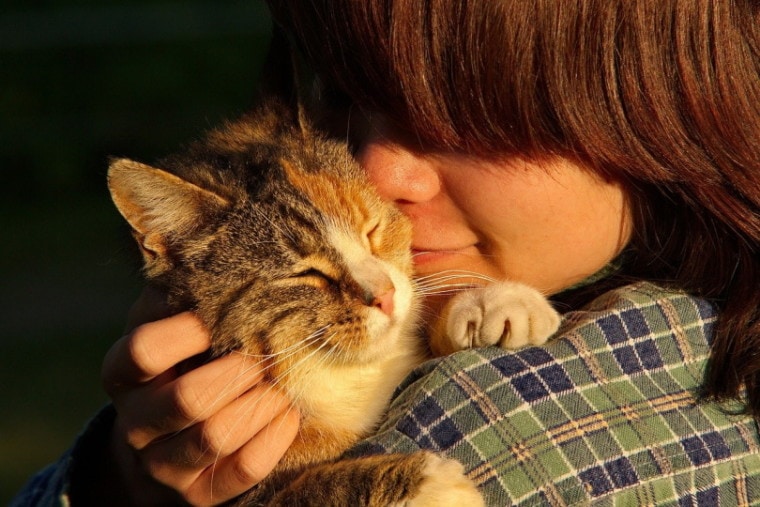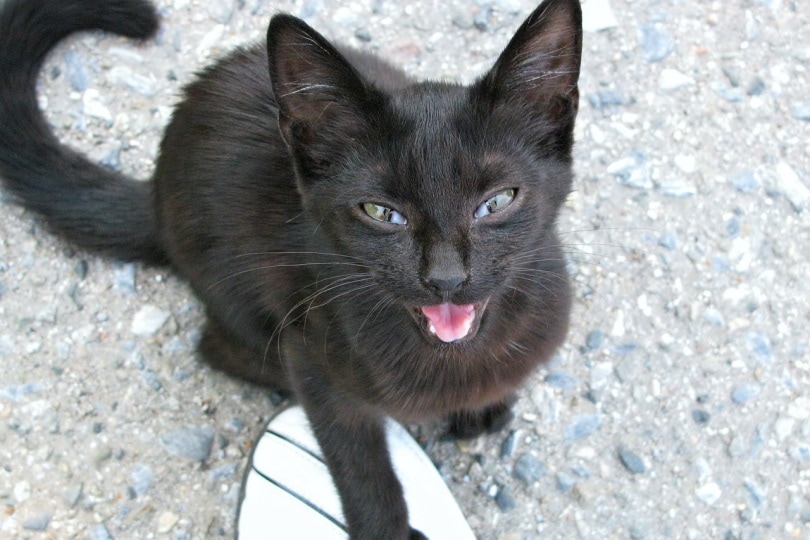
The concept of an “alpha” is typically associated with dogs. Some trainers believe that every pack of dogs has an “alpha1” leader and that the other members of the pack defer to this leader. Many animal behavior experts2 have called the alpha dog concept a myth3, but what about cats?
The answer is no, cats don’t have an alpha human. In fact, the very idea of an alpha human doesn’t exist in the feline world. Cats are independent creatures who don’t feel the need to follow anyone’s lead.
To understand why cats don’t have an alpha human, it’s important to first understand how their social structure works.
Cats Are Solitary Animals
Unlike their bigger cousins like lions and tigers, cats don’t naturally live in groups. In the wild, they’re typically solitary creatures. They only come together during mating season, and even then, they disperse soon after.
While clowders (groups of cats) do exist, they typically form around a food source and lack a real social hierarchy. In other words, there’s no one cat in charge of the clowder. Everyone just sort of does their own thing.
This solitary lifestyle extends to the domestic cat world as well. Even though cats live in close proximity to each other in our homes, they don’t form the same type of bond as dogs do with their pack.
Cats Don’t Defer to Humans
Since cats don’t have an innate desire to follow anyone’s lead, it’s unlikely that they would ever defer to a human. In their mind, we’re just another member of the clowder—not a leader.
So, all those “alpha” training methods, such as making your cat submit to you, forcing them to sit before you pet them, or walking through doorways first, are completely pointless. And if you try to use them, you’re likely just to stress out your cat without getting anywhere.

Do Cats Have a Favorite Human?
If you live in a multi-person home and own a cat, you’ve probably wondered if your feline friend has a favorite human. While cats may not have an alpha human, they can certainly form deep and lasting bonds with individual people.
Still, the process is far simpler than our concept of “favoritism.” In the cat world, there’s no such thing as choosing one person over another. Instead, cats simply gravitate toward the people who treat them the best. For instance, a cat is more likely to bond with a human who provides them with regular meals, plenty of toys, and lots of love and attention.
Since cats are excellent communicators, they also connect more with people who understand their cues. If you can read your cat’s body language and vocalizations, they’re more likely to see you as a friend and confidante.
How Cats Show Love and Affection
Cats have always been portrayed as cold, aloof creatures, but they’re actually quite affectionate pets! They just express their love in different ways than dogs and humans do.

How to Form a Closer Bond with Your Cat
Just because your cat doesn’t defer to you or follow you around all the time like a pup, it doesn’t mean you can’t be best friends. You do have to understand how to speak their language, though.
Here are some tips for forming a closer bond with your cat:
1. Respect Their Independence
Cats are naturally independent creatures, so it’s important to respect that they may not always want to be cuddled or petted. Instead, let them come to you when they’re ready for affection. This way, they’ll feel in control and more comfortable around you.
2. Learn Their Language
Do you know what your cat is “saying” when they meow, purr, or flick their tail? If not, it might be time to learn a little bit about cat body language.
For example, stress in cats can manifest itself in different ways, such as excessive grooming, urinating outside the litter box, or becoming more aggressive. A meowing cat may not be looking for attention or trying to be annoying—they may be hungry. The better you understand cat language, the better you can cater to their needs.
3. Create a Safe, Comfortable Environment
Cats feel safest when they’re in familiar surroundings, so try to create a space in your home that’s just for them. This could be a cozy spot with a soft bed, some toys, and a few of their favorite things. When they have a space that’s all their own, they’ll be more likely to relax and feel comfortable showing you affection.
4. Make Sure Their Basic Needs Are Met
Cats need food, water, shelter, and clean litter to go potty in. Failing to meet these basic needs will only make them stressed, aggressive, and in some cases, afraid of the world around them, including you. A full and warm cat is a happy cat, and a happy cat is more receptive to affection from their humans.
5. Research the Traits of Their Breed
Some cat breeds are naturally more affectionate than others. For example, Ragdoll cats are known for being particularly loving and trusting of their humans. On the other hand, Persian cats are often more independent.
When you know what to expect from your cat’s breed, you can better understand their behavior and learn how to best form a bond with them.

6. Be Patient
Cats can be slow to warm up to new people, and even those they’ve known for a while. It takes time to form a close bond with a cat, so don’t expect miracles overnight. Instead, focus on building trust and mutual respect no matter how long it takes.
Conclusion
Cats are unique creatures—independent but affectionate, aloof but loving. If you want to be close to your furry companion, forget about all those alpha-animal dominance games. Instead, learn to speak their language and show them the love and respect they deserve. With time, patience, and a little bit of effort, you’ll have a loyal friend for life.
See also:
- How and Why Do Cats Choose Their Favorite Person? Facts & FAQs
- How Do Cats Show Submission? 5 Vet-Reviewed Gestures
Featured Image Credit: JensEnemark, Pixabay









